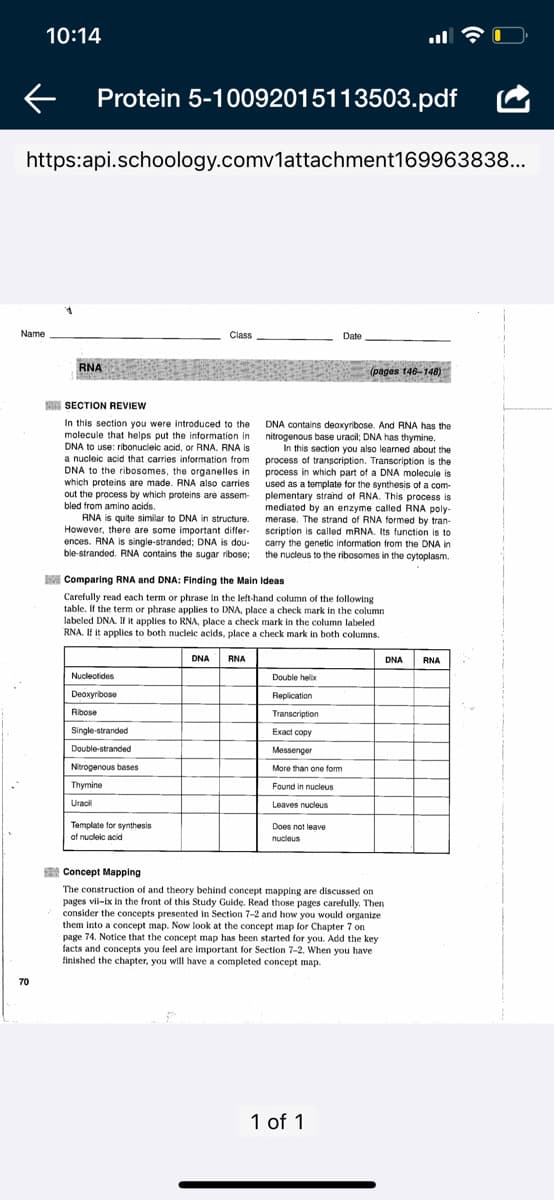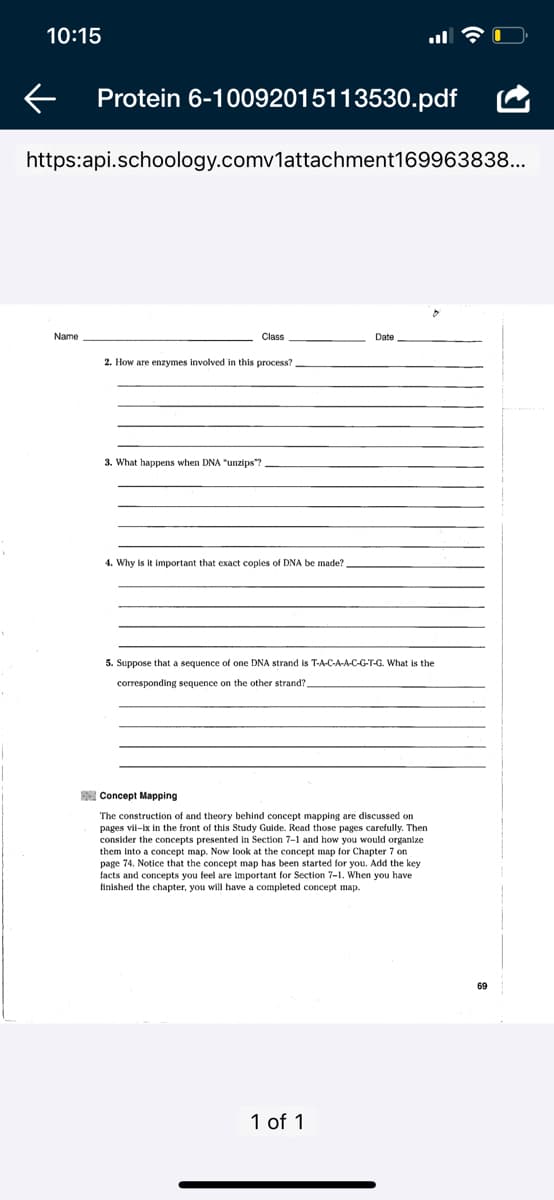Human Anatomy & Physiology (11th Edition)
11th Edition
ISBN:9780134580999
Author:Elaine N. Marieb, Katja N. Hoehn
Publisher:Elaine N. Marieb, Katja N. Hoehn
Chapter1: The Human Body: An Orientation
Section: Chapter Questions
Problem 1RQ: The correct sequence of levels forming the structural hierarchy is A. (a) organ, organ system,...
Related questions
Question
complete question number
two through 5 (page 69)

Transcribed Image Text:10:14
Protein 5-10092015113503.pdf
https:api.schoology.comv1attachment169963838...
Name
Class
Date
RNA
(pages 146-148)
SECTION REVIEW
In this section you were introduced to the
molecule that helps put the information in
DNA to use: ribonucleic acid, or RNA. ANA is
a nucleic acid that carries information from
DNA to the ribosomes, the organelles in
which proteins are made. RNA also carries
out the process by which proteins are assem-
bled from amino acids.
RNA is quite similar to DNA in structure.
However, there are some important differ-
ences. ANA is single-stranded; DNA is dou-
ble-stranded. RNA contains the sugar ribose;
DNA contains deoxyribose. And RNA has the
nitrogenous base uracil; DNA has thymine.
In this section you also learned about the
process of transcription. Transcription is t
process in which part of a DNA molecule is
used as a template for the synthesis of a com-
plementary strand of RNA. This process is
mediated by an enzyme called RNA poly-
merase. The strand of RNA formed by tran-
scription is called MRNA. Its function is to
carry the genetic information from the DNA in
the nucleus to the ribosomes in the cytoplasm.
Comparing RNA and DNA: Finding the Main Ideas
Carefully read each term or phrase In the left-hand column of the following
table. If the term or phrase applies to DNA, place a check mark in the column
labeled DNA. I it applies to RNA, place a check mark in the column labeled
RNA. If it applies to both nucleic acids, place a check mark in both columns.
DNA
RNA
DNA
RNA
Nucleotides
Double helix
Deoxyribose
Replication
Ribose
Transcription
Single-stranded
Exact copy
Double-stranded
Messenger
Nitrogenous bases
More than one form
Thymine
Found in nucleus
Uracil
Leaves nucleus
Template for synthesis
of nucleic acid
Does not leave
nucleus
Concept Mapping
The construction of and theory behind concept mapping are discussed on
pages vii-ix in the front of this Study Guidę. Read those pages carefully, Then
consider the concepts presented in Section 7-2 and how you would organize
them into a concept map. Now look at the concept map for Chapter 7 on
page 74. Notice that the concept map has been started for you. Add the key
facts and concepts you feel are important for Section 7-2. When you have
finished the chapter, you will have a completed concept map.
70
1 of 1

Transcribed Image Text:10:15
Protein 6-10092015113530.pdf
https:api.schoology.comv1attachment169963838...
Name
Class
Date
2. How are enzymes involved in this process?
3.
hаppens
anzips"?
4. Why is it important that exact copies of DNA be made?
5. Suppose that a sequence of one DNA strand is T-A-C-A-A-C-G-T-G. What is the
corresponding sequence on the other strand?
E Concept Mapping
The construction of and theory behind concept mapping are discussed on
pages vil-ix in the front of this Study Guide. Read those pages carefully. Then
consider the concepts presented in Section 7-1 and how you would organize
them into a concept i
page 74. Notice that the concept map has been started for you. Add the key
Now look at the concept map for Chapter 7 on
concepts you
are important
Secti
When you have
finished the chapter, you will have a completed concept map.
69
1 of 1
Expert Solution
This question has been solved!
Explore an expertly crafted, step-by-step solution for a thorough understanding of key concepts.
Step by step
Solved in 2 steps

Knowledge Booster
Learn more about
Need a deep-dive on the concept behind this application? Look no further. Learn more about this topic, biology and related others by exploring similar questions and additional content below.Recommended textbooks for you

Human Anatomy & Physiology (11th Edition)
Biology
ISBN:
9780134580999
Author:
Elaine N. Marieb, Katja N. Hoehn
Publisher:
PEARSON

Biology 2e
Biology
ISBN:
9781947172517
Author:
Matthew Douglas, Jung Choi, Mary Ann Clark
Publisher:
OpenStax

Anatomy & Physiology
Biology
ISBN:
9781259398629
Author:
McKinley, Michael P., O'loughlin, Valerie Dean, Bidle, Theresa Stouter
Publisher:
Mcgraw Hill Education,

Human Anatomy & Physiology (11th Edition)
Biology
ISBN:
9780134580999
Author:
Elaine N. Marieb, Katja N. Hoehn
Publisher:
PEARSON

Biology 2e
Biology
ISBN:
9781947172517
Author:
Matthew Douglas, Jung Choi, Mary Ann Clark
Publisher:
OpenStax

Anatomy & Physiology
Biology
ISBN:
9781259398629
Author:
McKinley, Michael P., O'loughlin, Valerie Dean, Bidle, Theresa Stouter
Publisher:
Mcgraw Hill Education,

Molecular Biology of the Cell (Sixth Edition)
Biology
ISBN:
9780815344322
Author:
Bruce Alberts, Alexander D. Johnson, Julian Lewis, David Morgan, Martin Raff, Keith Roberts, Peter Walter
Publisher:
W. W. Norton & Company

Laboratory Manual For Human Anatomy & Physiology
Biology
ISBN:
9781260159363
Author:
Martin, Terry R., Prentice-craver, Cynthia
Publisher:
McGraw-Hill Publishing Co.

Inquiry Into Life (16th Edition)
Biology
ISBN:
9781260231700
Author:
Sylvia S. Mader, Michael Windelspecht
Publisher:
McGraw Hill Education